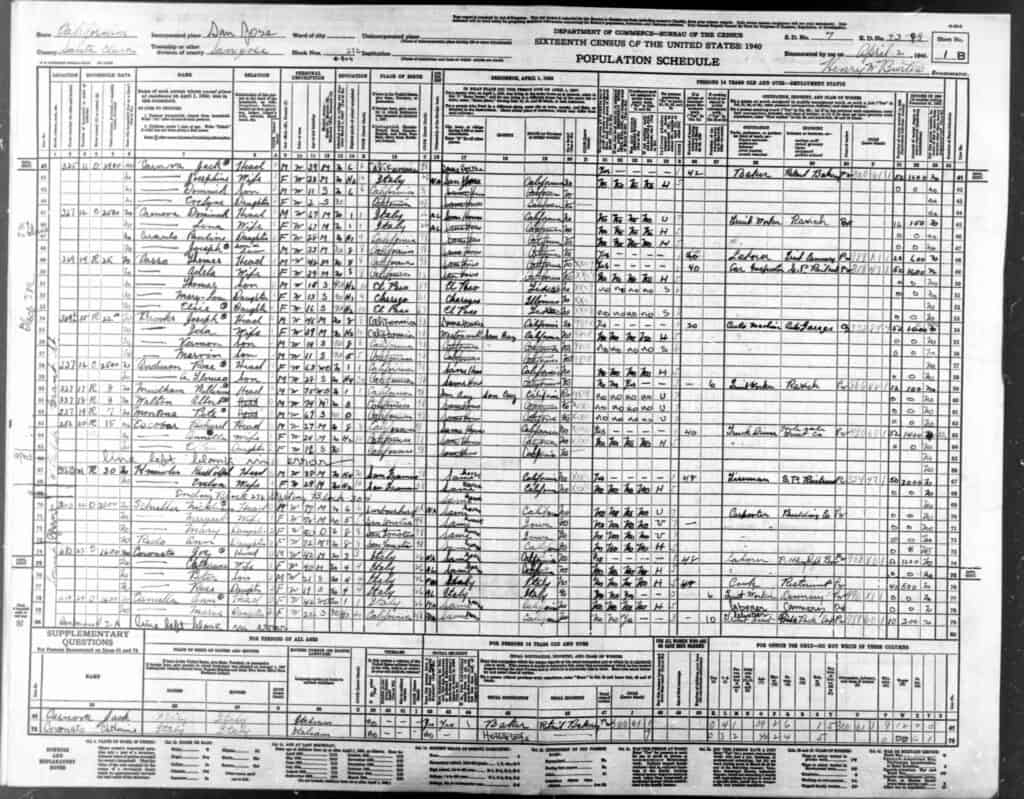My Family’s Story:

While my grandparents did not move from Italy to the United States until the 1950s, the area in San Jose, CA that they moved to was already red-lined and marked as “hazardous” by 1940.
From anecdotal stories passed down from my grandparents, this area was run down and overcrowded. The people there struggled to make end’s meet, often working long hours for little pay. My own grandmother worked as a laborer in a cannery nearby, which according to the site, was a popular employer of this community.

Area D11: An Italian Slum
According to the Mapping Inequality website, area D11 (represented in red by the map above) was a “Zoned multi-family residential, industrial and business. This is one ‘Italian Town’ and contains the slum section of San Jose.” 75% of the residents of this area were foreign-born Italians, like my family.

The Coronato Family’s Example
Below is the 1940 census data representing the intersection of Grant and Locust streets, located in area D11 (see star on map above.)
Because I do not have the exact address that my family lived at in this area, I chose a family from the 1940 census that resembled my family’s background: the Coronato family.


The Coronato family lived at the intersection between Grant and Locust street, marked with a star in the map above. All four family members were born in Italy, just like my grandmother’s family. The father, Joe, was a laborer who worked hard to provide for his family, without taking a single week off the entire year. The mother, Catherane, took care of the household. Both parents were 42 years old. Their 21-year-old son, Peter, worked as a cook in a restaurant. The 19-year-old daughter, Rosa, was a worker at the cannery, the same place my own grandmother worked.
The family made a combine annual income of $1700, on par with the average income of families living in this area.
The example of the Coronato family gives valuable insight into the realities of people living in this “slum,” which are similar to the experiences of my own family. While my grandparents were able to eventually move out of this “hazardous” area, they have told me of their difficulty in receiving a home mortgage because of the immigrant status and current residence in a red-lined area. It took them until the 1970s to be able to leave area D11. This demonstrates the lasting impacts of red-lining policies on the people who lived there in the past, and its continued effects in the modern day.
Featured Image Source: Festa in Little Italy. New York, 1908. Photograph. https://www.loc.gov/item/95511738/. Note: This photograph is not of San Jose, but it does represent what a “Little Italy” slum looked like in a different part of the country.


A wonderfully written story. Glad you were able to make the personal connection with your grandparents story. An excellent idea to use a similar family from census as well as to find a great representative photo for featured image.
Great layout makes for an enjoyable read. Excellent
Hi. Found this post via Prof. Pappas’ stack.
Good work and very meaningful to me. I was born in San Jose and over the course of decades lived in severable neighborhoods, including the one you featured (mid-1980’s). I moved there to be closer to the factory I worked in (which itself had moved from Los Gatos). By then the neighborhood was looking up, because the economy was treating San Jose well. I lived in a modest (probly 1960’s of 70’s) duplex. It is still there as of 2022 (per googlemaps). The neighborhood was then and is still made up mostly of one-story single family homes of varying ages, plus duplexes and fourplexes. Very interesting and to me vibrant community surrounding the Sacred Heart Church on Virginia St. I lived a couple blocks from there on Palm St.
The old folks I knew then called it Goosetown. The older Italians I knew came from more upscale neighborhoods by then, but had memories of it. Because I worked in the bicycle industry I knew lots of cyclists, many of them Italian American. They had tons of stories of racing at the track a few blocks west near Race St. One of them was instrumental in getting the current velodrome built in the early 60’s at its location further south.
By the time I lived there the inhabitants were very multicultural, which showed just walking the neighborhood, but especially along the commercial corridors, where there were few items one could not buy. San Jose, a very rideable city, was accessible in all directions, so what I could not find locally I’d ride a few blocks to get elsewhere.
All to say this neighborhood, tho partially cut off from downtown by the physical redlining of the interstate, has risen from whatever idiot designation the planners assigned it. Whether its properties are appropriately appraised these days is something I do not know.